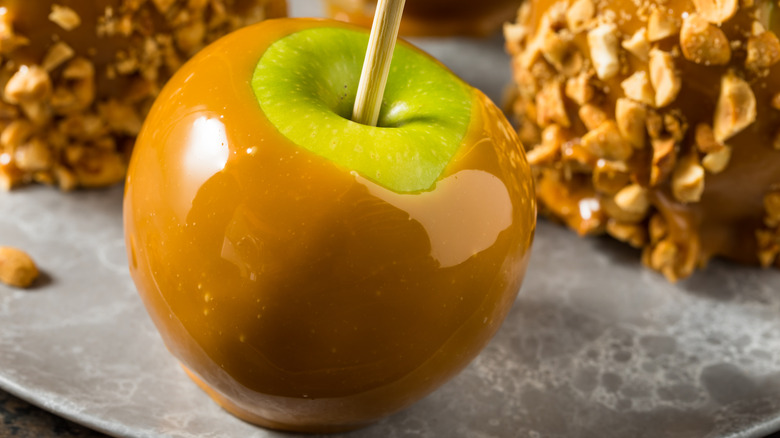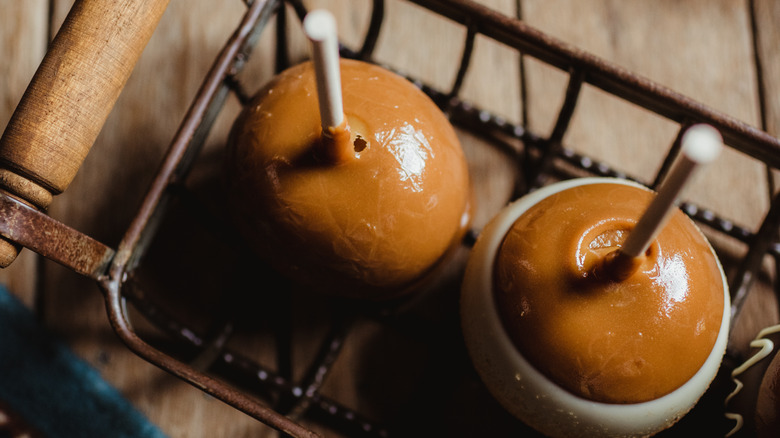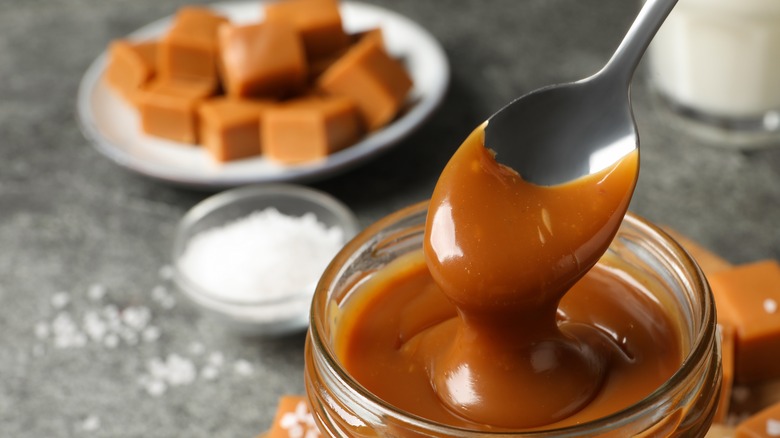The Key To Perfectly Melted Caramel For Apples
We may receive a commission on purchases made from links.
A classic caramel apple is a common sight at family-friendly festivals, sweet and portable treats that they are. But caramel is a tricky, goopy substance to work with, and dipping your apple straight into a mixture that's not at the right consistency is going to make a dripping mess. Some spatter is impossible to avoid when it comes to caramel (keep your aprons close at hand), but you can make the process simpler by melting down solid caramels and adding milk to the mixture before you dip.
It's tempting to try and make caramel sauce from scratch, but if the balance isn't right, your attempts might be too runny to adequately harden. Buying solid caramels like Werther's Original, Kraft, or Peter's Caramel (which comes in giant caramel "loaves") and microwaving them until they melt saves a lot of trouble, and adding milk into the mixture makes it creamier and a little thinner. This makes it perfect for dipping, and the caramel will stay on the apple until it cools.
Sticking it to caramel apples
You shouldn't need to do any cooking here, since you're not making the caramel yourself (more on that in a moment). Instead, you can place the solid caramels in a bowl, pour in some milk (about 2 tablespoons for every 10 ounces of caramel), microwave the mixture, and stir a little.
After that, it's a pretty quick process: once the caramel has cooled a little, dip the apples into the batch and allow any excess sauce to dribble back into the bowl, then set the apples on wax paper to cool. And don't forget to skewer the apple with a wooden stick before you dip.
So you've mastered the art of melting caramel and milk into a sweet, sugary coat for your apples; what can you stick to the outside of that melted caramel? Crushed peanuts are the classic choice, but chocolate chips and crushed Oreos or other candies also make great stick-to toppings if these apples are meant for dessert instead of an afternoon outdoor snack.
The science of melting sugar
If you're interested in trying, it's not too difficult to make your caramel instead of melting candies. Caramel is, in short, nothing more than burned sugar. You make caramel by taking white sugar and slowly cooking it until it melts down, turns light brown, and takes on a deep, buttery taste. Caramel and butterscotch are similar, except that caramel comes from white sugar and butterscotch comes from brown sugar.
When making caramel from scratch, lots of recipes will require cream of some kind to help the sauce thicken. Often, they'll call for heavy cream, which is much thicker than regular milk and makes the sauce well-suited for drizzling over cake and vanilla ice cream — milk is likely to curdle while being cooked this way. But for caramel apples, you want to be careful not to cook a straightforward caramel sauce that can drizzle off the apple too easily. To thicken homemade caramel, you can add even more heavy cream or cook it for longer.


